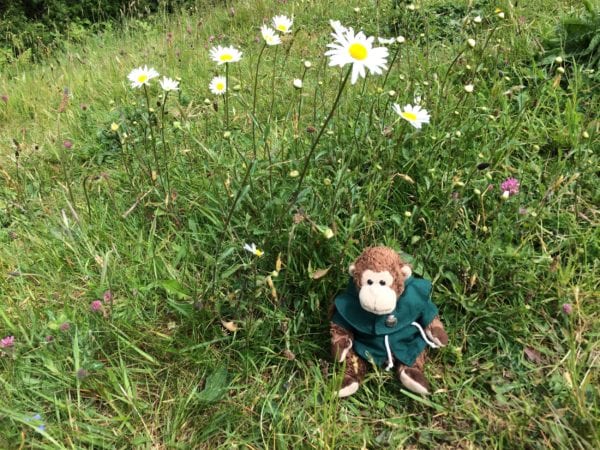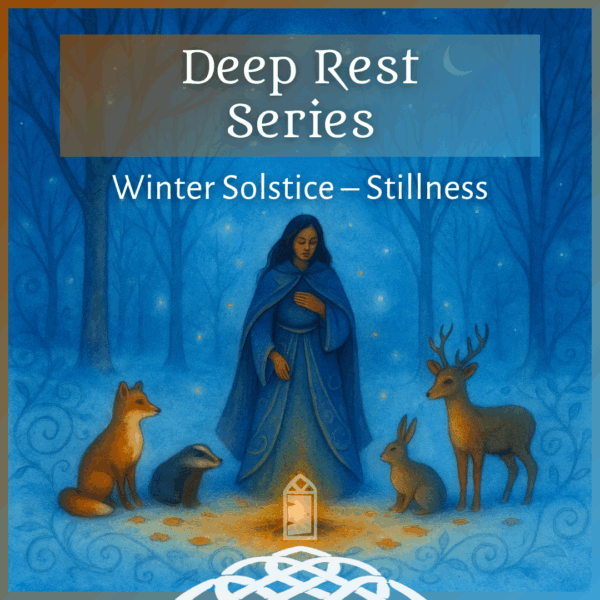Hello, gentle readers! This series of 12 essays were composed during John & Christine’s Jubilee Year (which began pre-pandemic, but some of which was written during varying degrees of lockdown). They were dictated to John by the Abbey’s mascot, Hildy the Monk-ey. Hildy is a bit of a free spirit who likes to entertain and doesn’t normally feel constrained by conventional story structure . . . or grammar, in general. She lives by the motto that “all stories are true; some actually happened.” We wanted to share them with you, our wider Abbey community, to give you a small monkey-sized window into life on the wild edges of Ireland. They will take the place of our Monk in the World guest posts until May when those will return.
 An té a luíonn le madaí, eiroidh sé le dearnaid.
An té a luíonn le madaí, eiroidh sé le dearnaid.
Greetings, my fellow pilgrims! ‘Tis I, Hildy – your friendly online mascot for the Abbey of the Arts.
This month’s Irish phrase roughly translates to, “he who lies down with dogs, gets up with fleas.” It’s usually used in the context of warning people about the type of company they keep. But I think it gives dogs a bad rep and my favourite dog, Sourney, certainly has no fleas on her (literal or figurative). And so today’s story is as much about her as it is about me.
You see (and I hope John is ready for this revelation), sometimes . . . I get on Sourney’s back and we go for a run up the canal and around the river!
(I’ll give John a moment to process.)
Yep. If Christine (who I think also just found out about this when John repeat-yelled it in disbelief) and John coordinate afternoon naps, then I will put Sourney’s harness on her and the two of us will go for a furry gallop along our favourite waterway. There. The truth is out in the open.
I feel so much better now. (John looks a little pale, but that’s kind of his natural color, so . . . )
John doesn’t believe I can ride Sourney like a person rides a horse. But I’ll have ye know, that in my youth, my siblings and I did a fair bit of mutton-busting. My parents, among other things, kept a small herd of sheep in the fields behind our house. And so warm, lazy summer days, my siblings and I would jump on the back of some sheep and race each other around the fields.
In hindsight, I realize that my parents were right to yell at us . . . as we were “worrying the sheep” and more than one of us got thrown off and broke a limb. (Not me, of course; I was the best and always won.)
But I am a good rider and Sourney is a . . . fairly good-ish . . . stead. Okay, to be completely honest: she’s a bit sporadic. She goes from wanting to bolt ahead at great speed to stopping on a dime to sniff something in great detail. I was going to say she’s unpredictable, but . . . It’s guaranteed that she’s going to want to bolt and then want to stop for a long time to sniff, every time. (Every. Single. Time.) She’s a dog; the nose must be obeyed. (What are ya gonna do, am I right?) But that’s not to say we don’t always have a blast and I enjoy the challenge of holding on as we navigate the trail.
The most difficult part of the whole thing is getting the harness on Sourney. She’s very sweet and tries to help, but she gets excited and jumps around a bit too much. I also have tiny hands and the buckle is kind of large for me. But I’ve got a prehensile tail and we always manage. Once we’re out of the building it’s a quick dash across the street and the first stop at the auld gate-keepers house. It’s a law office now, but originally was the home and office of the man (John Keogh) who was responsible for collecting fees for barges taking goods along the canal that connected the Claddagh Basin in Galway City and County Mayo, by way of Lough Corrib.
(John helped with some research and even I learned a bit of history about the place we live. Like . . . ) The Eglinton Canal was a publics work programme that was constructed between 1848 and 1852. The idea was to create a better economic routine between Galway and Mayo. But by the time it was done the roads were also greatly improved and once the automobile was introduced, the canal fell into disuse. But it did employ a lot of people in the area towards the end of the Potato Famine (and that was good).
Anyway, back to our run. A quick sniff and piddle at the corner (“checking her messages” as Christine likes to say) and we’re off again, past a wall that always has some lovely commissioned graffiti on it. It’s too bad Sourney is colour blind, as she can’t fully appreciate it.
Next we race past what was one of the last locks on the canal. The old wooden gates lasted until just a couple of years ago when the rotting timbers were finally replaced by cement brinks. It’s a lovely little waterfall in the middle of the city and there’s a wee grassy area on the other side of a small foot bridge over the lock that’s a nice place to stop and . . . But Sourney is not one for stopping for too long and so . . . Past the remaining wall of an auld saw mill and on we go!
Another, what Americans call, “block” and the path opens up a bit as we saunter by some lovely two story houses with front lawns and trees along the canal. Another stop or two by Sourney, perhaps a quick chat with one of her dog friends and we’re opposite Nun’s Island. It’s named after the convent of cloistered Poor Clare nuns that have lived there for ages! Like, they were there way before they tore down the old Goal (jail) and build the Cathedral, reusing the same stones.
The canal goes for another “block” past the university (NUIG or the National University in Galway) and the rowing clubs and ends at a marina. But we turn right over a bridge and head into Millennium Park. ‘Tis a lovely wee park with a modern playground for kids and a rundown skate park, with the cloistered nuns just over the wall from it. Sourney and I will stop here sometimes and make up stories about novices sneaking over the back wall of the convent at night to skateboard. (It could happen!)
But eventually we exit the park via another footbridge next to the Cathedral and we run down an older canal that separates the church from the convent and scare a bunch of sleeping ducks. I swear Sourney thinks she’s eventually going to catch one someday and . . . do what with it, I’m not sure. But I whoop and shout to give them a heads up to get out of Sourney’s way. (Sourney just thinks I’m getting into the fun of the chase, so let’s not tell her.)
The next bit of our usual routine is the second trickiest bit. We cross over the river here at the Salmon Weir Bridge. There’s a lot of traffic, most times of the day, and a VERY narrow footpath for pedestrians. The city council have plans to build a second, wider footpath only bridge here, but . . . neither Sourney nor I are holding our breath for that to happen any time soon. I mean, do NOT get us started on humans and their politics.
Let’s talk about the River Walk, instead!
The stroll along the canal (with the gentle water so close you could reach out and touch it) and the walk along the river (with its raging torrents of water several meters below) are two very different experiences. The Corrib River may be the shortest in all of Europe, but it makes up for that in speed and volume of water. There’s quite a drop in elevation from Lake Corrib that feeds the river and the Galway Bay where the river ends, so . . . it’s not a river to mess with.
Although . . . when the tide is very low (and the Corrib is tidal, being so close to the Bay and the Atlantic) the occasional angler can be seen wading in to do a bit of fishing! But also, kayakers like to play in the rapids created by not-quite high tide. The river is never the same and so always a delight.
Along the river, we often see grey herons and swans and cormorants. But Sourney is more interested in the ducks that sit between the two canals along the east side of the river. The one nearest the river is called the Middle River and the other one is rarely mentioned by name. It’s called Blood River, because the primary school it runs past used to be a slaughter house. (Sure, a bit gory. But the St. Pat’s students are cute and just recently co-ed and so more than make up for the gruesome history.)
Any-hoo, this is where Sourney and I usually have a bit of a . . . shall we say . . . discussion on whether to go one more “block” to the Wolfe Tonne Bridge or turn at O’Brien’s Bridge to head for home. The decision depends if we want to go pick up some croissants at the bakery or have some tea at the café.
Sometimes we do both.


